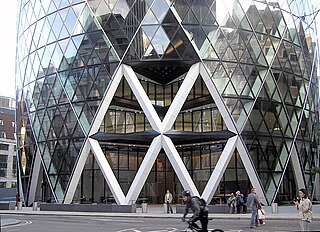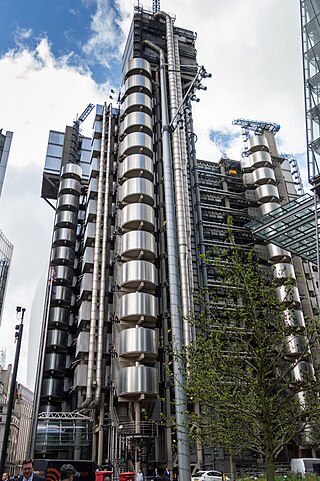
Norman Robert Foster, Baron Foster of Thames Bank, is a British architect and designer. Closely associated with the development of high-tech architecture, Foster is recognised as a key figure in British modernist architecture. His architectural practice Foster + Partners, first founded in 1967 as Foster Associates, is the largest in the United Kingdom, and maintains offices internationally. He is the president of the Norman Foster Foundation, created to 'promote interdisciplinary thinking and research to help new generations of architects, designers and urbanists to anticipate the future'. The foundation, which opened in June 2017, is based in Madrid and operates globally. Foster was awarded the Pritzker Prize in 1999.
Leslie Earl Robertson was an American engineer. He was the lead structural engineer of the Twin Towers of the original World Trade Center in New York City, and served as structural engineer on numerous other projects, including the U.S. Steel Tower in Pittsburgh, Shanghai World Financial Center, and the Bank of China Tower in Hong Kong.
Brutalist architecture is an architectural style that emerged during the 1950s in the United Kingdom, among the reconstruction projects of the post-war era, but commonly known for its presence in post-war communist nations. Brutalist buildings are characterised by minimalist constructions that showcase the bare building materials and structural elements over decorative design. The style commonly makes use of exposed, unpainted concrete or brick, angular geometric shapes and a predominantly monochrome colour palette; other materials, such as steel, timber, and glass, are also featured.
The year 1982 in architecture involved some significant architectural events and new buildings.
The year 1967 in architecture involved some significant architectural events and new buildings.

The Glasshouse is an international centre for musical education and concerts on the Gateshead bank of Quayside in northern England. Opened in 2004 as Sage Gateshead and occupied by North Music Trust The venue's original name honours a patron: the accountancy software company The Sage Group.

The Aloft Liverpool Hotel, formerly the Royal Insurance Building, is a historic building located at 1-9 North John Street, Liverpool, Merseyside, England. It was built as the head office of the Royal Insurance company.

A diagrid is a framework of diagonally intersecting metal, concrete, or wooden beams that is used in the construction of buildings and roofs. It requires less structural steel than a conventional steel frame. Hearst Tower in New York City, designed by Norman Foster, uses 21 percent less steel than a standard design. The diagrid obviates the need for columns and can be used to make large column-free expanses of roofing. Another iconic building designed by Foster, 30 St Mary Axe, in London, UK, known as "The Gherkin", also uses the diagrid system.

High-tech architecture, also known as structural expressionism, is a type of late modernist architecture that emerged in the 1970s, incorporating elements of high tech industry and technology into building design. High-tech architecture grew from the modernist style, utilizing new advances in technology and building materials. It emphasizes transparency in design and construction, seeking to communicate the underlying structure and function of a building throughout its interior and exterior. High-tech architecture makes extensive use of aluminium, steel, glass, and to a lesser extent concrete, as these materials were becoming more advanced and available in a wider variety of forms at the time the style was developing – generally, advancements in a trend towards lightness of weight.

Ditherington Flax Mill, a flax mill located in Ditherington, a suburb of Shrewsbury, England, is the first iron-framed building in the world, and described as "the grandfather of skyscrapers", despite its five-storey height. Its importance was officially recognised in the 1950s, resulting in it becoming a Grade I listed building. It is also locally known as the "Maltings" from its later use. The mill is in the hands of Historic England and is currently in use as a mixed-use workspace and exhibition following its official opening in 2022.

Hornby Village Institute is a public building in Main Street, Hornby, Lancashire, England. It is considered to be important architecturally, and is recorded in the National Heritage List for England as a designated Grade II listed building.
Anthony James Hunt, familiarly known as Tony Hunt, was a British structural engineer of numerous world-renowned buildings, with a career spanning from the 1950s until his retirement in 2002. As a leading proponent of British High Tech architecture and with a strong interest in both engineering and industrial design, Hunt was a major player in creating the High Tech movement of Norman Foster and Richard Rogers. He formed Anthony Hunt Associates in 1962. He worked with Rogers and Foster on Reliance Controls building in Swindon (1966) which was the first building of the British High Tech architecture, or more generally the High Tech architecture style. He was also a structural engineer on the Waterloo International railway station in London (1993).

The Selfridges Building is a landmark building in Birmingham, England. The building is part of the Bullring Shopping Centre and houses Selfridges Department Store. The building was completed in 2003 at a cost of £60 million and designed by the architecture firm Future Systems. It has a steel framework with sprayed concrete facade. Since its construction, the building has become an iconic architectural landmark and seen as a major contribution to the regeneration of Birmingham.
Roy Fleetwood is a British architect and designer. He is director of the Office for Design Strategy in Cambridge, England.
The Ship is an office building in Derriford, Plymouth, England. It was the offices of The Herald and Western Morning News for many years until their move to Millbay in 2013. It was recommended for listing at Grade II* by Historic England in April 2015.

Wendy Ann Foster was a British architect and co-founder of Team 4 and Foster Associates.

The ASN Co building is a heritage-listed building located at 1–5 Hickson Road, The Rocks, Sydney, New South Wales, Australia. Completed in 1885 and built in the Pre-Federation Anglo Dutch style under the direction of William Wardell and his associate, Walter Liberty Vernon, the building served as the principal offices and warehouse for the Australasian Steam Navigation Company until the company's merger in 1887, when the Government of New South Wales acquired the land used for ordinance facilities and later as government administration offices. Since 1989 the building has been owned by the Sydney Cove Redevelopment Authority and its successors. The building is currently used as an art gallery to display the works of Ken Done.

The Old Bushells Factory is a heritage-listed former Bushells Tea factory and warehouse, now used as shops, offices and an art gallery, located at 86–88 George Street in the inner city Sydney suburb of The Rocks in the City of Sydney local government area of New South Wales, Australia. No. 86 was designed by Walter Liberty Vernon; and both buildings were built from 1886 to 1912. It is also known as the Old Bushells Factory and Warehouse; Bushells Place; Bushells Warehouse and Bushells Offices; and Health Commission Building (Bushell's). The property is owned by Property NSW, an agency of the Government of New South Wales. It was added to the New South Wales State Heritage Register on 10 May 2002.

73 York Street is a heritage-listed former warehouse and now office building located at 73 York Street, in the Sydney central business district in the City of Sydney local government area of New South Wales, Australia. It was built in 1892, with the design having been attributed to Herbert S. Thompson. It is also known as Henley House, Hardware House, ICLE House, Monte Paschi House and Cassa Commerciale House. It was added to the New South Wales State Heritage Register on 2 April 1999.
British high-tech architecture is a form of high-tech architecture, also known as structural expressionism, a type of late modern architectural style that emerged in the 1970s, incorporating elements of high tech industry and technology into building design. High-tech architecture grew from the modernist style, using new advances in technology and building materials.














